

8. Souris City


I
can’t count the number of times that while
driving westward along Highway #2 near Wawanesa I’ve
taken a brief glance southwards as I crossed the bridge and thought,
“That looks interesting.” You only have time to catch
a glimpse of a steep cutbank cliff and the winding river that brushes
against it, a mere hint of a wild looking landscape. You get another
glimpse as you crest the hill and, for most of us, that’s all you
see. We’re all busy. We’ve got places to go.
Where you to
stop at the western rim of the valley, as I did one day, you will be
surprised to find out how easy it is to get a much better view. A
conveniently placed crossing offers a road allowance south from Highway
#10 that you might mistake for a lane to a farmyard. The road ends
abruptly, and indeed does lead to the entrance of private lane, but it
is a public road allowance, and there, a few hundred metres from a busy
highway, if you get out of your car and walk a few steps you will be
rewarded with a river valley view that can only be described as
panoramic.
As you will see, the Souris River takes a
dramatic S-curve
before speeding under the highway bridge and twisting its way to
Wawanesa. If you take a close look you will see for yourself how
the river, as it turns from one side of the deep valley to the other,
has
carved steep bank when it hits the a valley wall leaving a wide level
valley bottom in between. There on the ‘flats’ was the
village of Souris City, a tiny but important nucleus of settlement
existed for a brief time in the 1880's until the railways routes were
finally settled and Wawanesa came into being.
At its birth Souris
City was one of many speculative “cities” that came with
the Manitoba Land Boom of 1881-82. This spot perfectly captures a view
of the entire flats, the dream and the reality that was Souris City.
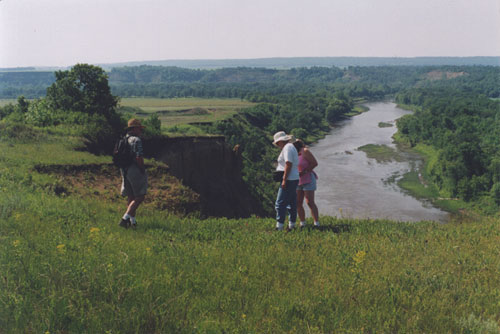
Overlooking the Souris City site - the
village was near the centre.
The photo was taken from a spot about 200 metres south of Highway #2.
The gamblers in this case were William Scott and his son William
J. They arrived sometime after October 1880 and bought land from
the CPR. Details are hazy but we do know that a survey of the town site
was prepared by J.W.Vaughan, and registered Nov. 14, 1881. The Scotts
then sold all their land to the Manitoba and Nor’West Land Co.
Ltd of which they were major shareholders. . [2] The company soon
became the Toronto, Manitoba and North West Co. Early in 1882 the
Winnipeg Daily Sun reports that, ”Mr. Scott, Manager of the
Toronto and Manitoba Northwest Land Company, sold last evening by
private sale $1100 worth of lots in Souris City.” The next month
an ad offered 320 acres adjacent to Souris City for sale. [3]
Before the establishment of the town, the area was referred to as the
"Elliot Settlement" after a family that had moved to the area in 1879
and were well established farmers by 1880. Millford pioneer Alex Reid
refers to them in his letters of that year, interestingly mentioning
their plan to put a small steamer on the Souris River to bring up
freight from Millford Landing or Souris Mouth. [3A] The Elliot name, in
fact outlasted the Souris City as it was given new life in the form of
"Elliot's Siding" a stop on the the railway that eventually arrived.
Thanks to a Winnipeg Daily Times report from September 25, 1882 we have
a concise summary of how the place looked then. Mr. J.S. McKay,
Presbyterian missionary to the area provides a detailed account of his
region in which he refers to Souris City as, “a somewhat
pretentious place” consisting of “ a saw and grist mill,
two stores, hotel, five private residences, a blacksmith shop, and
several tents.” He goes on to extol the agricultural potential of
the region, to bemoan the fact that although there were “ten
Presbyterian families and about a dozen young men,” they
were “very careless” about church attendance. He
should be forgiven if he seems to regard the local Methodists with a
somewhat jealous eye, as he notes that they are in the majority and
that they “have service every day”. His services were
conducted every fortnight in Mr. Harrison’s store, and
he appreciated that the storekeeper, a Methodist incidentally, made it
available. He concludes the Souris City portion of his report by
allowing that, Should a railway be constructed through it, Souris City
may come to be an important place.”
All this
and more under the headline. “The March of
Christianity”, amply subheaded with the following: “Through
the Fertile Valleys of the Little and Great Souris, One of the Finest
Framing Districts in the Whole Northwest, Increasing Value of the
lands…”Men Growing Rich While They Sleep”. They knew
how to write headlines in those days! [4]
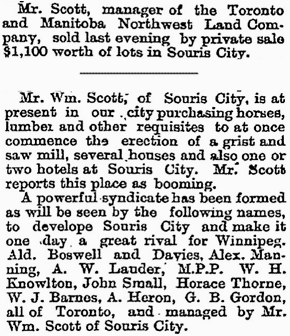 Winnipeg
Daily
Sun, Jan. 26,
1882
Winnipeg
Daily
Sun, Jan. 26,
1882
The grist mill, which was steam powered, was located along the river
bank on the east side of the flats. [5] Local farmers had been hauling
grain to Millford for this purpose, and for farmers to the southeast
the trip to Souris City was shorter and over an easier trail. Some
local histories speculate that this mill is one and the same with the
Gregory Mill located a few miles upstream, but a report in the Brandon
Sun in 1889 contains explicit references to both mills. [6] The
likelihood is that the mill at Souris City was not nears as large an
operation as Mr. Gregory’s and served a purely local need.
Other
businesses thrived as well. A brickyard was established by Mssrs. Freek
and Coupland. It was located on the escarpment, past the northern
limits of the village, and produced a low quality type of brick used
for the lining of wells. Some decades ago, heavy trucks hauling
gravel out of a pit now located alongside the old trail exposed bricks
from the old brickyard site and shards were still visible on the trail
when I last walked it in 2005. A Mr. John Harris found his niche in the
manufacture of axe and hammer handles. A local settler,
James (Jabez?) Elliott, who had been selling a few provisions out of
his home opened a store in the new town. Mail service was soon
established and the details are interesting for two reasons. For
one thing the location of early postal stations remind us how things
have changed.
By 1884 the
holdings of the “Toronto Company” which
included the townsite was managed by newcomer Thomas Nichol. [7]
Today, south of
Brandon the most obvious major centres would be Souris and
Wawanesa. In those days the mail came by stage along a route that
stopped at Rounthwaite, Millford, and Two Rivers. Neighbouring
“post settlements” included Carrolton, Hayfield and
Strathhearne. Anyone predicting which settlements would lead the
coming rural economic boom would have likely focused on Souris City and
Millford.
The other interesting thing about mail service is its importance to the
naming of settlements. The Dominion Government would assign post
offices and direct the post master in the task of establishing
names. The government idea was to assign historic, often native
names to post offices. The local idea was often to name them
after the postmaster.
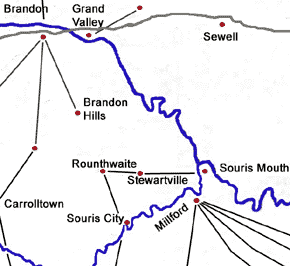 Postal Routes, 1880's
Postal Routes, 1880's
In the case of Souris City, it happened that the name was already taken
by a settlement south of Melita, so the name Sourisbourg was
used. Then the Indian word Wawonaissa (whipoorwill) became the
official name. Finally, in 1884, Souris City could be used
because the original Souris City had been abandoned. This did
cause a bit of an identity problem. Even the first store in town
was unsure of what to call itself, opting for "Sourisburg."
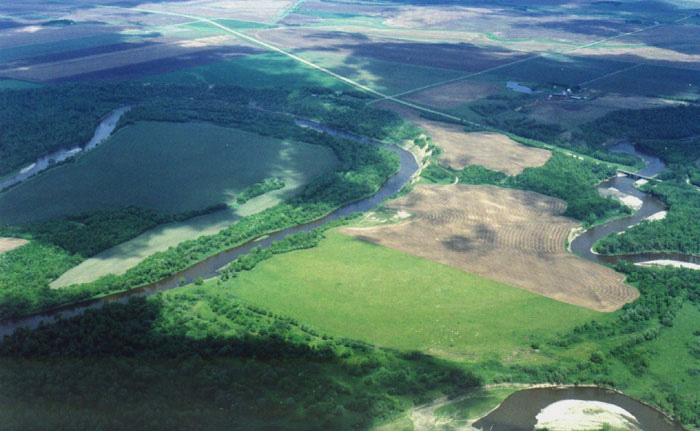 Souris
City was located near the bottom left
Souris
City was located near the bottom left
of
this shot.
That Souris
City was considered a central point is further shown by the
fact that a second mail route was established from Souris City to
Langvale and points south. Its total population at its peak was
fifty four, but that was no indicator of its importance to the
surrounding neighborhood. By 1882, the nearby Elliot settlement
contained about fifteen farmers, each with over 100 acres under
cultivation. Not only were many settlers coming, but they were
breaking land quickly and buying recently invented farm equipment so as
to improve production.
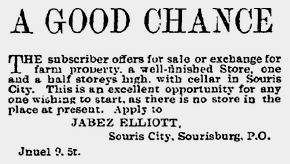 Brandon
Sun - July 24, 1884
Brandon
Sun - July 24, 1884
By 1883, when a series of Farmer’s
Conventions were held in three
locations across the province, one of those locations was Souris City
[8] The topic, as it invariably was when farmers gathered was the
government and how they understood about the settlers’
needs.
Much of what
we do know comes from newspaper reports. We know that a school
was operating. We know that the village’s second
schoolteacher, Edmund Batty, shot himself in the upper arm while
getting out of a wagon on Oct. 10, 1884, leaving a wife and five
children. [9] A doctor from Brandon summoned but he had lost too much
blood and died the next day. We know that churches were
established and that they for some time shared the services of Mr.
Hall, the Methodist minister from Millford. In fact at one
revival meeting he is said to have read a passage from Revelations
which induced a mother of eight to “confess” a
“mishap in her childhood” on the Isle of Skye 30 years
earlier. Her husband kicked her out and she was soon found to be
working in a Brandon Hotel. [10]
We know that the first recorded death in the new community was that of
a young Englishman named Aborn, employed by the brickyard. He
drowned one Sunday morning while swimming in the river. The site
of his grave is uncertain but the grave of a Stuart Robertson and his
wife is marked by a tombstone in the southwest corner of SE17.7.17.
[11] We don’t know if that was the official graveyard or
if, as was common, people had their own “private”
cemeteries - which is a way of saying they buried them in the back yard.
The Souris City region had its share of notable citizens and characters
as befitting a settlement of its regional importance.
Noted early settler Jabez Elliott’s store was listed as
“one and a half storeys high, with cellar” in
1884 when he offered to sell it or trade for a farm. (At that
time the address was Souris City, Sourisburg. P.O. The Oakland
Municipality elections of 1884 saw Richard Kinsley Esq. of Souris City,
returned as a Reeve. That same year a Miss Nichol was advertising her
skills as a “first class dress maker”. In 1889 Dr. H.
Aubrey Husband in the spirit of helpful citizenship, wrote a letter to
the Brandon Sun warning parents against “a mist dangerous
practice, far too common in this country, of administering to young
children indiscriminate doses of laudanum and other preparations of
opium.” A Mr. A, Williamson had an illustrated catalogue
advertising his stock which had “no superior on this
continent...” and inviting people to call in at his farm which he
called “Penketh” [12]
Another local
of
widespread fame was “Prof” Alfred Grainger.” It seems
Mt. Grainger was a somewhat mysterious figure who fro a period made his
living as an itinerant music teacher, traveling from settlement to
settlement with a portable piano demonstration keyboard, offering
instruction. He is mentioned in news reports from the area, often in
connection with a Concert or Musical Evening. The Sun noted in 1888
that “ ‘Lovely Souris River’ is the title of a new
work for the piano forte and violin composed by Prof. Alfred Grainger,
of Souris City.” [13]
According to one local historian Mr. Granger came from England and was
discovered as it were working as a farm hand in Millford. He plyed his
trade throughout the 1890's then disappeared until the 1920’s and
later disappeared again for good. [14]
The initial boom did not last and by 1883 this part of Manitoba was
battling both poor crops and a recession. The real estate bubble had
burst but life went on for the determined settlers who were here and
decided, rightly so it would appear to ride out the bad times.
As it has ever been,
school finances were an issue, and even though the
teacher salary was $50 a month, school closed for lack of funds in
April 28 1883. This was worse than it seems because school was
more of a summertime thing in those days. Apparently it opened
again later that summer. [15]
Indeed it is interesting to speculate on what would have happed to the
established Manitoba towns like Souris City, Nelsonville, Millford and
others if the recession and poor crops of 83-84 hadn’t dampened
both immigration and income. Would some of the centres like Souris City
have become so well established that it wouldn’t make sense to
bypass them? Or would railways have continued the policy of the CPR in
avoiding settlements so as to save money on land purchases and make
more on increased value of the same land when it came time to sell?
We’ll never know.
The businessmen
in these early towns were very conscious of the importance of
transportation links. The problem with setting up town sites near
rivers is that there is usually a need to get to the other side.
A pioneer from the Boissevain district remembered walking from Brandon
to his home via Souris City because water was high and he could cross
on the ferry there. This was in 1882.
Before the railway, the old trails were used for trips to markets grain
in Brandon, for mail delivery and stagecoach service. Souris
City’s position on a main trail depended upon having a river
crossing. A bridge was a top priority. The first hastily-constructed
one was washed out in 1884. It had been built in 1882, evidently
by the Souris City Co. the owners/managers of the townsite. This was
before Oakland Municipality was established. By 1884 the
municipality was beginning to take responsibility for such things
although a communication in the South Cypress News mentions
contacting the said company regarding s Ferry Cable. [16] It had been
built at a substantial cost ($9000 according to local Mr. H.H.
Saunderson, $30000 according to a report in the Winnipeg Daily Sun on
the 27 of November 1882. Under a heading reading “The Bountiful
Harvest, Two Hundred Thousand Bushels of Wheat Harvested at Souris
City”, the report based apparently on interview with Mr. W. Freek
who also reported that his brickyard had manufactured 150000 brick th
at year. [17] Local legend has it that it was swept away by ice laden
waters the evening before a government official was supposed to have
presided over the Grand Opening. In any case it didn’t last
long and a ferry service was quickly reestablished. It operated
daily from six am until 8 pm, and the rate was 25 cents per team and 10
cents a pedestrian. (Return free of charge on same day, 6 am - 8 pm.)
In 1884 Oakland council decided that they would “allow” the
“Toronto Company” to put the bridge back subject to council
supervision [18] A notice in the Sun from March of 1885 reads;
“In the matter of the Souris City bridge its control has been
taken over by the Municipality of Oakland, pending a settlement of the
cost of such care and maintenance between all the municipalities
interested. [19]
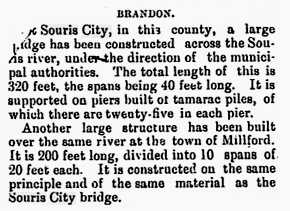 The
Winnipeg
Daily Times, Dec. 19, 1883
The
Winnipeg
Daily Times, Dec. 19, 1883
While details regarding the building of bridges is sometimes uncertain
we do know that it was the subject of much debate at the municipal
government level. Everyone agreed that a bridge was necessary but
local taxpayers thought that the municipalities to the south that would
benefit should foot some of the bill.
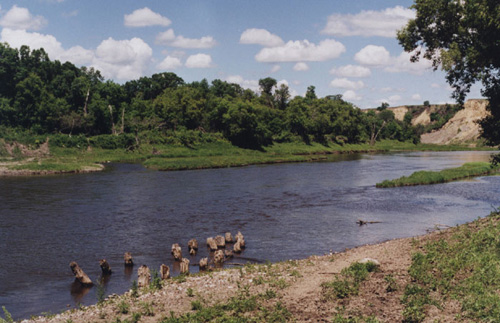 In
low water, the remains of the bridge were still
visible in 2001
In
low water, the remains of the bridge were still
visible in 2001
Nearby South Norfolk Municipality was given notice that
“they had removed the bridge over the Souris, at Souris City, and
would not replace the same or make any provision for crossing at that
point unless a portion of the cost be borne by this
municipality.” [20]
A new bridge with a removable span was built at some point. The
centre span could be removed during spring breakup to avoid
destruction. It was, however, costly to maintain, and as far as
we know the settlers to the south didn’t pay any of the
costs. Oakland ratepayers paid an annual bridge bill until 1889.
By that time
the writing was on the wall for the future of Souris City as a budding
metropolis. All the hopes of the townsite had rested on the
possibility of a rail crossing. The problems were twofold.
First; the CPR had a deal with the Canadian Government that no
competing line would be allowed south of it’s main line for 25
years after the construction of that line. This meant that
they were in no hurry to satisfy the needs of smaller markets in newly
settled areas. Second; even if lines were constructed to the
south there was no guarantee that the Souris City site would be
chosen. By 1886 only three or four businesses remained.
That the railway didn’t come quickly to this part of the province
wasn’t for lack of effort and imagination. There were various
efforts at convincing government to act, various proposals for rail
lines.
In 1884 with a
good crop and surplus grain piling up the settlers were
becoming quite concerned. Thomas Nichol of Souris City, presumably on
behalf of “The Toronto Company” (Souris City town site
owners) offered to supply the rails if the municipalities of Oakland
and Cornwallis would do the grading for a railway from Brandon to
Souris City. The offer was not accepted. [24]
Another proposal was the
Brandon Souris and Rock Lake line. The first
mention I find of it is in a Nov. 22, 1884 edition of the Winnipeg
Daily
Sun, where they report on what looks like an organizational meetings
held in Millford and Souris City. Among the directors of the
proposed enterprise were T. Greenway the M.M. P. from Crystal City who
would change local railway history more definitively a few years later
when he gave up Federal Politic and became the Premire. Other directors
were representatives from various affected communities like R. Kinsley
(sic) from Souris City and Alex Reid from Millford. T. Mayne Daly of
Brandon was solicitor. These folks were the prominent people of the
area. [21]
An editiorial in the Sun
in 1886 gets behind this, as it generally did
when it came to boosting the region. It bemoans the lack of
action. “We were hopeful that assurances would have been
afforded, before this, that it was the intention to provide railway
facilities for Millford, Souris City and Plum Creek districts this
season” and goes on to extol the virtues of the regions settlers
and wonder what they would have accomplished if given decent
transportation for their crops. [22] (BSN 080486)
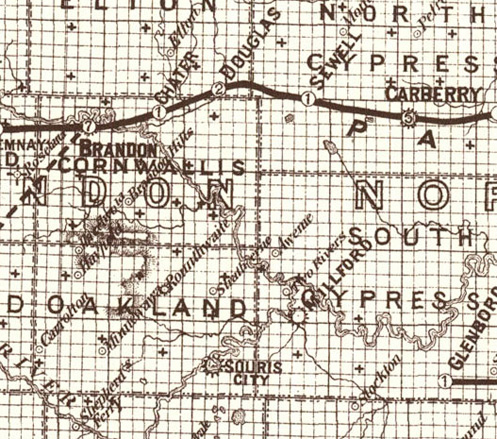 Note
the place names in this map from 1886. Souris City and Millford were
the
only villages in the
Note
the place names in this map from 1886. Souris City and Millford were
the
only villages in the
region - the other names denote Post Offices.
But still there was hope. In June of 1886 Mr. D. McKinley of the
district was reporting to the Sun that engineers were at work
“endeavoring to locate the extension of the C.P.R. Southwestern.
It is hoped that they may be successful in carrying the line through
the district…” [24]
The railway
problem, which ultimately spelled out its doom, did however bring
Souris City into the provincial spotlight for a short period of time.
1884 saw the inauguration of the Oakland Branch of the Farmer’s
Union. The meeting was held at Souris City School and was well
attended. The union, fueled in part by the depression that started with
a dry year in 1883, initiated a fight for local rights. There
were two key issues. One was a government policy of high
agricultural product tariffs, which led to high machinery prices.
And the other was the monopoly of CPR. Part of their platform
included the “right of local government a to charter railways
anywhere in Manitoba...”. [25] Across the west there were
feelings of dissatisfaction with the Federal Government - not entirely
unrelated to the dissatisfaction of the Saskatchewan Metis that
culminated in the Rebellion of 1885. There was the feeling, quite
justified, that the Federal Government, far off in Ottawa, didn’t
understand or care much about the prairie settlers. There were
declarations of rights, subtle and not-so-subtle threats of succession,
and even appeals to Queen Victoria.
One issue was resolved when, in 1888, the newly elected provincial
government under Premier Thomas Greenway, was able to break the CPR
monopoly. That was the beginning of a crucial time in the
history of Souris City and district.
Earlier, on April of 1888, the line was not even on paper yet. The Sun
reported that “An application will be made…to build an
operate a line of railway from or near the city of Brandon, thence in a
southeasterly direction, crossing the Souris River at or near Souris
City….[26]
By April 25 of 1889 the Sun under the heading “The Line
Located” was reporting that tenders for construction of the line
had been invited and that the route from Morris to Souris City had been
set. As we will see, apparently the actual site of the crossing was
either not settled or not made public. It is interesting to note that
all along the line new towns were about to be created, but at this
point the old names prevailed. Dry River, Otenaw and Craigilea are on
the route, their counterparts, Greenway, Baldur and Belmont
aren’t mentioned as they don’t yet exist. [27]
Here it is important
to reflect on the nature of the rural
“villages. When someone said they were from Souris City, they
didn’t necessarily mean the “village” of Souris City,
in that same way, when I was growing up I said I was from Baldur
without
feeling the need to say “ a farm near Baldur”. When
the Sun reported that the rail line would cross the Souris a Souris
City, I’m sure no one took it for granted that this meant that
the rail line would cross at precisely that point where the small
village happened to be.
On the 11 of July, as a “Big Picnic” was being planned to celebrate the
end of the monoploy and the coming of a railway link, a
reporter notes that: “Things are becoming serious here at
present, and there is considerable speculation as to where the town
will be located.” [28] The wording is interesting. There is no
assumption that the crossing will be at the village. What would it
really matter? There were only a few buildings there. To the vast
majority of the regions inhabitants, the important thing was that they
were getting a rail line. End of story.
The
twelfth of September brings a report that the new station “at
Souris City: will be called “Sippawisk”. [29] On the 31 of
October we begin to learn those new names, some of which are still with
us today, some not. Greenway, Belmont, Hilton come into being. The town
of Wawnesa is reported as being “principal to the Souris City
townsite. ”. [30] It was in fact 3 kilometres to the
northeast. But close enough for many.
Between Wawanesa and Brandon we learn of McNaught (Rounthwaite) and
Martin. Martin (Martinville) didn’t last long, Rounthwaite
still has a few buildings on the townsite.
A big celebration, which the Brandon Sun reported as a
“Monster” Picnic in their typically understated tones, was
held in Souris City on August 1, 1889. The Sun claimed that 2000
people attended. The Premier was the guest of honor. A follow-up
article in the Sun under the heading “They Have the
People’s Gratitude” was glowing in its portrayal of Mr.
Greenway and his government for their efforts to end the monopoly and
it is assumed, final address the needs of the rural communities. It
notes that citizens would have “shown themselves in the last
degree ungrateful if they had neglected to manifest the satisfaction
they must have experienced in seeing so signal a victory achieved over
their enemies and deceivers. They recognized in Mr. Greenway and
his colleagues the possession of courage, patriotism, persistence and
honesty of purpose…” [31]
Before long the
Northern and Pacific Railway had by this time nearly
completed their new line from Morris to Brandon, but they decided to
cross the river a few miles downstream. The new town of Wawanesa
came into being without a great deal of fanfare. Home and
business owners wasted no time. During the winter of 1890 most of the
buildings were put on skids and dragged them to the new town of
Wawanesa. By March of 1990 residents were expecting the railway to be
in full operation by April. [32]
By the 28 of November we
learn that the new town of Wawnesa is thriving
and that locals are “looking for the opening of the N.P.&M
railroad to carry away our grain. The road is likely to open for
traffic this week” [33]
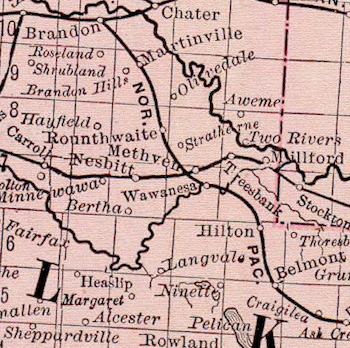
On this map from 1892 Souris City has disappeared and Wawanesa is
well-established.
Unlike several other towns in Westman that have slowly disappeared over
decades, the demise of Souris City was swift and certain. The
municipality had already decided to cut some of the losses by
dismantling the expensive bridge and using the parts in culvert
construction programs at various points in the municipality.
Community focal points shifted to both the newly formed village of
Wawanesa, and to the nearby local school / church district of Chelsea.
Interestingly this was not an occasion for sorrow or regret. In fact,
by 1890 this had happened over and over again throughout western
Canada. It was just a fact of life. Reports in Brandon Sun remark upon
the birth of Wawanesa without mention of the demise of Souris City. It
was really not a big deal. In a narrow sense the investors on the
actual town site of Souris City might not have achieved their
objectives, but the people of the district got what they wanted.
Mr. Nichol, while he never did see a “City” come out of the
Souris City, did keep making the most of the situation. An ad from a
June 2nd 1892 edition of the Sun has him selling 2100 acres of
farmland, which he promoted as being “Within 2 ½ miles of
2 railway stations… with 4 elevators nearby. Souris River runs
through the property.” [34] So that is what became of
Souris City! His address was still Souris City and the other
contact was Mr. W. H. Knowlton from Toronto, the same Mr. Knowlton who
gave notice a few years earlier of the intention to form the Rock Lake,
Souris City and Brandon Railway. [35]
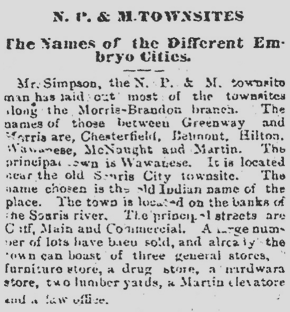 Brandon
Sun, Nov. 31, 1889
Brandon
Sun, Nov. 31, 1889
As for the remnants of the townsite itself, a
few buildings were put on
skids and hauled down the river. The hotel had already been moved
across the river and served for some time as a residence. In fact, as
reports in the Brandon Sun indicate villages and towns were just not
that important. In fact it was the railways that made town important.
Before the rails country stores sprang up anywhere, like school and
churches they were independent of a “village”, they served
a region. Neighbourhoods, often centering on a school, were the focus
of regional news. This isn’t surprising in that in those early
days most of the population lived on farms.
 The
Souris City Hotel -
was moved across the river and used as a residence.
The
Souris City Hotel -
was moved across the river and used as a residence.
Photo
from Oakland Echoes
Never the less, there were some hard feelings over the details. A local
news report from 1890 highlights one problem:
“There is a general feeling of disapproval over the appointment
of Mr. Wm. Foster to the position of postmaster here. He has nothing to
recommend him beyond the fact of his being a Tory.” The writer
wondered why Mr. Nichol, the who held the position at Souris City and
was willing to move, should have got the job. [36]
The site
retained it attraction and even its identity, for some time.
The Brandon Sun noted that the local Methodists were using the site for
a picnic in 1894. [38] Now farmland and pasture, it is was known by
locals as The Souris City Flats long after most signs of settlement had
vanished. Clifford McFadden, a grandson of pioneer Richard Kinley,
recalls berry picking there with his mother, and how she was able to
point our where various dwellings and stores had been. [37]
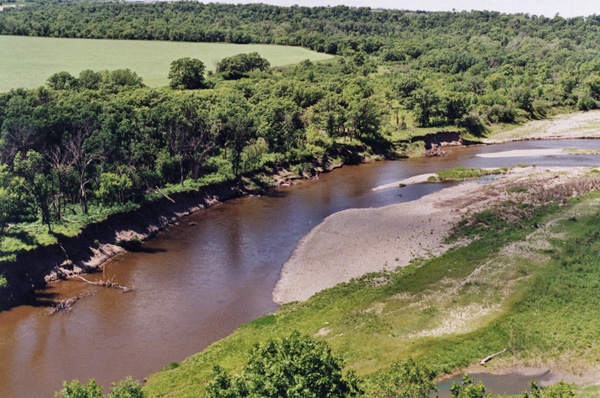
The Souris City site in 2011.
The site is accessible only by river or by traveling through private
farmland. However, if you do find yourself on Highway #2 near
Wawanesa, it is worth your while to stop on the upper west side of the
valley, and take a look south. It’s rough country with
steep cliffs where the Souris has cut into the valley walls, and one of
the most interesting spots, geologically and geographically in western
Manitoba. But, considering the importance of easy
transportation links, perhaps it wasn’t the best place to build a
town.

Sources
1. McFadden
, Clifford R. Souris City, Manitoba Pageant , Winter 1972, Volume
17, Number 3
2. Stuart, J.A.D. , The Prairie W.A.S.P (A History of the Rural
Municipality of Oakland Manitoba) Prairie Publishing Company,
Winnipeg, Mb
3. Winnipeg Daily Sun 20,02,82
3A. Alex Reid, Letters and Journal, Archives of Manitoba, Microfilm
Ref. MG8 B61
4. Winnipeg Daily Times, September 25, 1882
5. Stuart 79
6. The Brandon Sun Weekly, 13,06,89
7 Stuart 164
8. Winnipeg Daily Sun 17,12,83
9. Stuart 82
10. McClung, Nellie, Clearing in the West, Thomas Allen, Toronto,
1935 134
11. Stuart 82
12. The Brandon Sun Weekly, 24,07,84 - 25,09,84 - 11,12,84 –
05,09,89 – 30,08,88
13. The Brandon Sun Weekly 19,07,88
14. Stuart 197
15. Stuart P129
16. The Brandon Sun Weekly 05,06,84
17. Winnipeg Daily Sun 27,11,82
18. Brandon Sun 12,04,84
19. The Brandon Sun Weekly 19,03,85
20. Portage La Prairie Press 24,07,85
21. Winnipeg Daily Sun, 22,11,84
22. The Brandon Sun Weekly 080486
23. The Brandon Sun Weekly 140289
24. The Brandon Sun Weekly 17,06,86
25. Stuart 131
26. The Brandon Sun Weekly 19,04,88
27. The Brandon Sun Weekly 25,04,89
28. The Brandon Sun Weekly 11,07,89
29.The Brandon Sun Weekly 12,09,89
30. The Brandon Sun Weekly 31,10,89
31. The Brandon Sun Weekly 05,09,89
32. The Brandon Sun Weekly 27,03,90
33. The Brandon Sun Weekly 28,11,89
34. The Brandon Sun Weekly 02,09.92
35. The Brandon Sun Weekly 14,02,89
36. The Brandon Sun Weekly 27,03,90
37. The Brandon Sun Weekly 25,06,
|
|
|